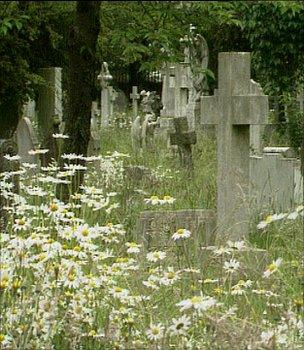Urban biodiversity beyond the grave
- Published
Student film: Beyond The Grave
"It was such a beautiful place, it was easy to capture on film," said film-maker Emma Cepek, explaining the lure of Manchester's Southern Cemetery as a location for a wildlife documentary.
Her film, Beyond the Grave, sets out to highlight the importance of cemeteries as vital habitats in urban areas.
"Whilst I was there, it was never a gloomy place. It was a place of life - there was a real sense of biodiversity," she explained.
The 40-hectare site, established in 1897, is listed on the national landscapes of special historic interest register.
Artist LS Lowry and football legend Sir Matt Busby are among the famous names to be have been laid to rest in the leafy surroundings.
Ms Cepek, a student on the University of Salford's MA course in wildlife documentary production, said: "It is a huge green space, and it is located just three miles from the centre of Manchester, which was one of the first industrialised cities.
"For Manchester, this more or less meant a wipe-out of all green spaces except for this one location."
Derek Richardson, principal ecologist for the Greater Manchester Ecology Unit, explained why the sites were deemed so important for biodiversity.
"As most cemeteries were laid out prior to the more industrial farming practices, they can be refuges for species that are not found in the wider countryside," he told BBC News.
"We have records in cemeteries near the city centre of foxes, badgers, deer, songbirds, as well as flora and invertebrates."
Light touch
He added that the locations also provided shelter for species because they were not as intensively managed as other urban green spaces.
"They are not like agricultural land, or even gardens, where you have herbicide spraying or slug pellets being put down.

Cemeteries offer a refuge to a wide variety of flora and fauna that would struggle to survive elsewhere
"So this means that the whole food chain is there, from invertebrates right up to the higher mammals - even close into the city centre."
He explained that mature or veteran trees, which were often originally planted as a feature of the cemetery - such as London's St Pancras Garden's "Hardy tree", an ash tree growing in the middle of a grouping of headstones which novelist Thomas Hardy planted as a young trainee architect, provided a valuable refuge for a wide variety of species.
Mr Richardson explained that, very often, bigger was better when it came to supporting biodiversity.
"Municipal cemeteries, like Southern in Manchester, are very big in scale, and that scale is very useful in terms of supporting more species, such as mammals that need more space."
The sites also provided a route for species passing through an urban landscape, he added.
"It does seem to be the case that you do not need green spaces to be physically connected as long as you have the stepping stones - and cemeteries provide those spaces.
"The fact that we are finding deer in cemeteries close to city centres in Salford and Manchester means that cemeteries are certainly being used as stepping stones.
Staff member Tommy Moran, who has worked at Southern Cemetery for 40 years, said that many of the natural features had been there much longer than any of the staff.
"In some places, the ivy has been there for over a hundred years," he said in the film, before acknowledging how the burial site has provided stability in a rapidly changing landscape.
"If Southern Cemetery was not here then you might have a factory with smoking chimneys, or a housing estate with a load of Asbos on it."
Emma Cepek said that it came to light during filming that some of the cemetery staff had trained as arborists, and they also encouraged wild flowers to grow among the headstones.
"During my time there, they were also constantly debating how much of the ivy needed to be cut back, and what trees needed to be cut back - it was fantastic atmosphere."
Advice in an English Heritage report, Paradise Preserved, external, offers guidance on maximising the benefits the areas offer wildlife.
This includes only cutting grass one, maybe twice a year, to encourage the growth of wild flowers that are important food sources of butterflies and pollinators.
The Greater Manchester Ecology Unit advises councils on the most effective ways to manage urban green spaces, including cemeteries.
Mr Richardson said that when developing strategies, the unit did understand that the primary use of the site had to be taken into account.
"What people want when they are visiting is signs that there has been some care of the site, but that is not totally at odds with managing wildlife," he observed.
"You can put up bird or bat boxes, sowing wild flowers, or encouraging hedges. These sorts of things do not make a site look unattractive, but nevertheless it is good for wildlife."